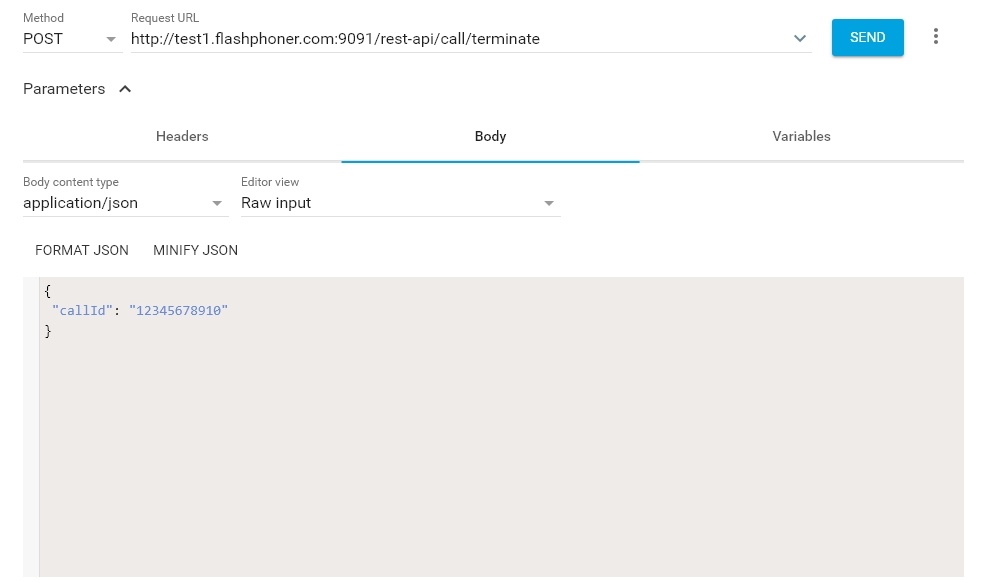Overview
A SIP call made through the WCS server can be captured into a stream on the server when the call is created. Then this call can be played in a browser using any method supported by WCS.
The stream captured from a SIP call can be republished to an RTMP server using the REST query /push/startup, just like any media stream on the WCS server.
Operation flowchart
- The browser starts a call using the /call/startup REST query
- WCS connects to the SIP server
- The SIP server sends the RTP stream of the call to WCS
- The second browser requests playback of the call stream
- The second browser receives the WebRTC stream
Quick manual on testing
1. For this test we use:
- two SIP accounts;
- the softphone to answer the call;
- the REST-client in the Chrome browser;
- the Player web application to play the stream.
2. Open the REST client. Send the /call/startup query to the WCS server and specify the following as query parameters:
- parameters of your SIP account the call will be made from;
- the stream name to republish the call to (the toStream parameter), for example, call_stream1;
- the name of your second SIP account the call will be made to.
3. Receive and answer the incoming call on the softphone:
4. Open the Player web application and in the "Stream" field specify the name of the stream the call is redirected to (in our example: call_stream1):
5. Click "Play". The stream starts playing:
6. To terminate the call, send /call/terminate from the REST client to the WCS server and pass the call id in the parameters:
Call flow
Below is the call flow when using the SIP as RTMP example to create the call and the Player example to play it
1. Sending the REST query /call/startup:
sendREST() code
function startCall() {
...
var url = field("restUrl") + "/call/startup";
callId = generateCallID();
...
var RESTCall = {};
RESTCall.toStream = field("rtmpStream");
RESTCall.hasAudio = field("hasAudio");
RESTCall.hasVideo = field("hasVideo");
RESTCall.callId = callId;
RESTCall.sipLogin = field("sipLogin");
RESTCall.sipAuthenticationName = field("sipAuthenticationName");
RESTCall.sipPassword = field("sipPassword");
RESTCall.sipPort = field("sipPort");
RESTCall.sipDomain = field("sipDomain");
RESTCall.sipOutboundProxy = field("sipOutboundProxy");
RESTCall.appKey = field("appKey");
RESTCall.sipRegisterRequired = field("sipRegisterRequired");
for (var key in RESTCall) {
setCookie(key, RESTCall[key]);
}
RESTCall.callee = field("callee");
var data = JSON.stringify(RESTCall);
sendREST(url, data);
startCheckCallStatus();
}
2. Establishing a connection to the SIP server
3. Receiving a confirmation from the SIP server
4. The RTP stream of the call is sent to the WCS server
5. The Browsers establishes connection to the server.
Flashphoner.createSession(); code
Flashphoner.createSession({urlServer: url}).on(SESSION_STATUS.ESTABLISHED, function(session){
setStatus(session.status());
//session connected, start playback
playStream(session);
}).on(SESSION_STATUS.DISCONNECTED, function(){
setStatus(SESSION_STATUS.DISCONNECTED);
onStopped();
}).on(SESSION_STATUS.FAILED, function(){
setStatus(SESSION_STATUS.FAILED);
onStopped();
});
6. Receiving from the server an event confirming successful connection.
ConnectionStatusEvent ESTABLISHED code
Flashphoner.createSession({urlServer: url}).on(SESSION_STATUS.ESTABLISHED, function(session){
setStatus(session.status());
//session connected, start playback
playStream(session);
}).on(SESSION_STATUS.DISCONNECTED, function(){
...
}).on(SESSION_STATUS.FAILED, function(){
...
});
7. Request to play the stream.
stream.play(); code
stream = session.createStream(options).on(STREAM_STATUS.PENDING, function(stream) {
var video = document.getElementById(stream.id());
if (!video.hasListeners) {
video.hasListeners = true;
video.addEventListener('playing', function () {
$("#preloader").hide();
});
video.addEventListener('resize', function (event) {
var streamResolution = stream.videoResolution();
if (Object.keys(streamResolution).length === 0) {
resizeVideo(event.target);
} else {
// Change aspect ratio to prevent video stretching
var ratio = streamResolution.width / streamResolution.height;
var newHeight = Math.floor(options.playWidth / ratio);
resizeVideo(event.target, options.playWidth, newHeight);
}
});
}
...
});
stream.play();
8. Receiving from the server an event confirming successful playing of the stream.
StreamStatusEvent, status PLAYING code
stream = session.createStream(options).on(STREAM_STATUS.PENDING, function(stream) {
...
}).on(STREAM_STATUS.PLAYING, function(stream) {
$("#preloader").show();
setStatus(stream.status());
onStarted(stream);
...
});
stream.play();
9. Sending audio- and video stream via WebRTC
10. Stopping playing the stream.
stream.stop(); code
function onStarted(stream) {
$("#playBtn").text("Stop").off('click').click(function(){
$(this).prop('disabled', true);
stream.stop();
}).prop('disabled', false);
...
}
11. Receiving from the server an event confirming unpublishing of the stream.
StreamStatusEvent, status STOPPED code
stream = session.createStream(options).on(STREAM_STATUS.PENDING, function(stream) {
...
}).on(STREAM_STATUS.PLAYING, function(stream) {
...
}).on(STREAM_STATUS.STOPPED, function() {
setStatus(STREAM_STATUS.STOPPED);
onStopped();
}).on(STREAM_STATUS.FAILED, function(stream) {
...
}).on(STREAM_STATUS.NOT_ENOUGH_BANDWIDTH, function(stream){
...
});
stream.play();
12. Sending the /call/terminate REST query:
sendREST() code
function hangup() {
var url = field("restUrl") + "/call/terminate";
var currentCallId = { callId: callId };
var data = JSON.stringify(currentCallId);
sendREST(url, data);
}
13. Sending the command to the SIP server
14. Receiving confirmation from the SIP server
SIP as stream recording
All streams captured from SIP calls can be recorded on server. To do this, set the following parameters in flashphoner.properties file:
sip_single_route_only=true sip_record_stream=true
The following codecs are supported:
- Video: H264
- Audio: opus, PCMA (alaw), PCMU (ulaw)
Stream recording is described here in details.
Known issues
1. Stream captured from SIP call, can not be played, if RTP session is not initialized for this stream.
Symptoms: SIP stream is published on server, but can not be played.
Solution: enable RTP session initializing with the following parameter
rtp_session_init_always=true






